Traveling with a baby doesn’t have to be guesswork. I first loaded my son into our camper at four months, then braved a Bucharest flight at five, and a winter road trip baby run across France before his first birthday. Each leg forced me to refine my baby travel tips, from sticking to our home nap rhythm to driving only when he sleeps and packing a mesh Quechua carrier that spared us both sweaty meltdowns.
This guide pools every lesson, checklist, and gear tweak I’ve tested (plus stories from families I met while sailing the Med). You’ll get plain answers on breastfeeding through TSA, picking an airline bassinet, booking an Amtrak infant ticket, and setting up a crib in a windswept campsite. Read on and you’ll step off the porch with a plan. There’s no need for frantic Googling at 3 a.m. All you need is a clear route to smoother days on the road, in the air, or under canvas.
Guide to Traveling With a Baby
Disclosure: Some of the links below are affiliate links. This means that at no extra cost to you, The Travel Bunny will earn a small commission if you click through and make a purchase. Thank you!
One-Minute Baby Travel Checklist for 2025
You don’t need to pack the nursery to survive a trip. I’ve learned the hard way that less fuss means fewer meltdowns, for both of us. Here’s the baby travel checklist I rely on before every departure. It covers the absolute essentials whether you’re facing your first road trip baby loop or flying with baby on a long-haul flight.
Essentials to Always Have Ready
- Passport and other child travel documents. If you’re traveling with a baby internationally, pack the baby passport, copies of both parents’ IDs, and a printed child travel consent letter if traveling solo.
- Feeding supplies. Bring breast milk TSA-approved containers, liquid formula TSA-sized packs, or sterilized snack tubs if your baby’s already on solids.
- Diapering kit. Include a foldable mat, sealable wet bag, travel wipes, and more nappies than you think you’ll need. Airplanes and road trip baby stops are not always diaper-friendly.
- Change of clothes. Pack at least two full backups, for both of you.
- Sleep tools. A portable white-noise machine (or app), muslin cloth, and if your baby uses one, their usual sleep sack. Familiar items = faster naps.
Parent Travel Tip: If you’re checking a stroller, ask at the gate if you can push it all the way to the plane. Most airlines allow stroller gate check at no cost.
Gear to Organise Smartly
In the early days, I lugged half our home. Now I stick to a core set:
- A lightweight travel stroller that folds fast for buses, trains, and airport security with baby and stroller lanes.
- A comfortable baby carrier travel sling. The Quechua mesh one saved us on sweaty hikes and ferry queues.
- A travel car seat that fits both rental cars and planes. Ours sometimes doubles as a backup nap spot.
- A travel crib if your hotel doesn’t guarantee one.
I keep these at home by the door, or directly in the car or camper, ready to grab for short hops or week-long road loops.
Baby Travel Hacks That Work
- Drive when the baby naps. Seriously. Nothing wrecks a trip like a car seat scream-fest in rush hour.
- Keep one bag exclusively for baby travel essentials. Mine stays stocked and zipped, so I never start from scratch.
- Don’t skip the sunscreen. I’ve made that mistake several times with my own skin. I even have a mark and spent the rest of the day with a shirt over the stroller.
Advice to Travel with Baby: On a long road trip baby run, stop every two hours. Even a ten-minute stretch helps them (and you) reset.
Next up: How to prepare before your trip, avoid common traps, and decide when your baby is actually ready to roll.
Pre-Trip Essentials. What to Do Before Traveling With a Baby
No matter how spontaneous you were before becoming a parent, traveling with a baby demands structure. The smoother your prep, the calmer your journey. I’ve tested this the long way, leaving in a rush with forgotten gear, missing essentials, and an overtired baby strapped in before he was ready. Don’t do that. Start here.
Medical Clearance & Minimum-Age Chart
If you’re wondering when can you travel with a newborn baby, you’re not alone. Most pediatricians say healthy full-term babies can fly from 2 weeks old, but we waited until 4 months. He was stronger, and I was less wobbly, too.
That said, many parents still ask: is it safe to travel with newborn? It depends on your baby’s health, the destination, and the travel method. For car travel, short distances with plenty of breaks are manageable. For air travel, check cabin pressure concerns, exposure to germs, and feeding logistics. I didn’t rush it, and I’m glad.
Check with your doctor first. Preemies or babies with respiratory issues might need clearance, especially for air travel.
Here’s a rough guide:
| Age | Travel Mode | Notes |
|---|---|---|
| 0 – 3 months | Short car trips | Best if you’re driving during naps |
| 3 – 6 months | Domestic flights | Get seats away from lavatories |
| 6 – 12 months | Get seats away from the lavatories | Prime travel age, before they walk |
| 12 – 24 months | Any | Just expect more movement and noise |
Newborn travel is doable, but I recommend short test runs first.
Documents, Consent Letters & Insurance
Start early on the paperwork. For international travel with baby documents needed, here’s what we’ve used across multiple borders:
- A valid baby passport (some countries require at least six months’ validity) once you get a good baby passport photo (tip: take it right after nap time, it helps with stillness).
- If only one parent is traveling, a child travel consent letter is required. Keep in mind that some countries require this to be notarized, so check early and plan ahead.
- Printed travel insurance for family with infant, with the baby named on the policy.
- Medical records, if you’re dealing with allergies or medication.
We never needed it, but knowing we had proper baby travel insurance gave us peace of mind, especially on our longer trips. Some providers even cover gear delays or emergency care abroad, so don’t rely on your own travel policy to extend to your child by default.
Parent Travel Advice: Keep hard copies of all documents required for baby international travel, not just PDFs on your phone.
Budgeting & Hidden Infant Fees
Don’t let the word “lap infant” fool you. Yes, babies under two often fly free domestically, but flying with a lap infant cost can still add up. Internationally, airlines often charge 10 percent of the adult fare, even if you don’t book a seat.
Other hidden fees I’ve seen (and sometimes paid for):
- Infant flight rules that charge for baby travel gear like checked car seats on budget carriers
- Cheapest airlines for lap infants often make you pay for extras like bassinets or advance boarding
- Local taxis that refuse to take a baby without a car seat
- Extra insurance premiums from rental companies covering infant equipment.
To plan a realistic baby travel budget, account for gear check fees, medical coverage, emergency supplies, and food/water needs, especially when breastfeeding is no longer your fallback. I always budget a buffer for last-minute replacements and things I forgot (like the time I bought a full-sized bottle brush at a campsite).
Newborn Travel Tip: Baby travel budget planning isn’t just about airfare. Factor in everything from backup nappies to train bassinets. You’ll travel calmer knowing the numbers are covered.
To make your trip easier on your wallet:
- Use the best travel rewards cards for families with infants
- Choose airlines that allow free travel stroller and travel car seat check-ins
- Compare gear rental vs bringing your own, especially for travel crib setups in hotels.
Up next: what to actually bring and what to leave behind when you’re traveling with a baby. Spoiler alert: you need less than you think.

Packing & Gear. What You Really Need When Traveling With a Baby
I’ve packed too much, too little, and once forgot nappies altogether. After dozens of trips (flights, camper loops, and cross-country drives), I’ve narrowed my system down to just what works. This section covers the baby travel essentials that earn their space, plus the smart extras I won’t travel without anymore.
Editable Packing List (and What to Leave Behind)
Every trip starts with a shared Google Sheet that my husband and I update before we zip the bags. It’s our running baby travel checklist. Here’s what’s always on it:
- Lightweight travel stroller (fits gate-checks easily, but you may prefer a cabin stroller)
- Travel car seat (ours works for the car, camper, or plane)
- Travel crib (hotel cots are hit or miss, and this gives peace of mind)
- Baby carrier travel sling (the Quechua mesh one kept both daddy and baby cool during our summer trips in France)
- Two full changes of clothes for baby, and one for each parent
- Nappies, wipes, wet bag, and diaper bag travel with extra zip pouches.
Optional but helpful:
- Small white-noise machine, story box, or app
- Roll-up mat for airport or roadside changes
- Lightweight blanket or thick scarf that triples as a nursing cover, sunshade, or towel.
I always keep emergency items together in one dry bag that moves from the camper to the overhead bin. It saves you from digging mid-crisis.
If you’re using a baby carrier travel solution, you may be asked to remove it during airport security checks.
Gear That Earns Its Weight
Best baby travel gear is the stuff you’d rebuy immediately if you lost it. These are mine:
- Best baby travel toys for flights. We rotate 2–3 small sensory toys that don’t light up or make too much noise. A crinkly book, a fine motricity toy, and a silicone teether kept us sane during our flights to Bucharest and back.
- Portable bottle warmer. My son is still breastfed, but that’s not the case for everyone. (No judgement here, fed is best!) For longer trips, especially when solids aren’t enough or you’re still pumping, you might use a portable bottle warmer. Skip this if your baby is used to drinking his milk at room temperature.
- Collapsible stroller. There are lightweight strollers that fit in the overhead bin. Their downsides are the high price and the light wheels that make them ideal for (some) city travel only.
- FAA approved car seat for airplane travel. We haven’t booked our son his own seat yet. But for longer flights, it can make the safest nap a baby can have at 30,000 feet.
- Packing list baby shortcut: divide by days, then layer for contingencies instead of tripling everything just in case.
I used to bring every possible what if item. Now I plan for one blowout, one lost toy, and everything else I can buy locally if needed.
Day-Saving Add-ons That Actually Work
Some gear earns a spot in your bag by saving your sanity, not just doing its job. These are the tools that made a difference for us:
- The robot rocker. Before he could fall asleep on his own, this was the only thing that soothed him in his stroller or crib. I still recommend it to other new parents on the road.
- The Quechua baby carrier travel. It has a breathable mesh, a secure fit, and it’s easy on my back. He’s been in it (and also slept in it) inside our home, but also out for village strolls, vineyard stops, and late-night stretches outside rest stops.
- A cooler backpack, great for snack pouches and milk/water on warm days.
- One cheap foldable high chair that straps to any table. It’s ideal for road-trip Airbnbs and rural restaurants with zero kid options. We’ve used it everywhere, but initially bought it for our camper because it takes up very little space when stowed away.
Skip bulky changing tables – you can use any flat surface once you protect it. Also, forget about the baby bathtub, because a sink will do at that age.
Keep reading to learn how to handle feeding on the go, including TSA-proof packing, bottle warming on flights, and what worked best when we moved from breast to solids.

How to Handle Mealtimes When Traveling With a Baby
Feeding your baby while you travel can feel like solving a puzzle on no sleep. I’ve breastfed in airplane seats, spoon-fed mashed avocado in a camper parked outside a bakery, and improvised bottle-warming with café kettles and hot water in jars. This section covers exactly how to manage breastfeeding on a plane discreetly, pack liquids through security, and keep a baby fed when they’d rather throw food than eat it.
TSA & Security Rules for Milk, Formula, and Solids
The rules are not as scary as you think, but you do need to know them. Here’s what worked for us and also what’s allowed.
- TSA rules for flying with breast milk let you bring more than 100 ml if it’s medically necessary. Breast milk TSA, liquid formula TSA, and even baby food TSA are exempt from liquid limits.
- If you’re unsure what qualifies, the answer lies in the full wording of the TSA liquid rules for formula and medicine. These allow gel packs, cold packs, and liquid medications for infants (even those over 100 ml), so long as you declare them at screening.
- Can I bring breast pump on plane? Yes, it’s allowed and does not count toward your carry-on limit when flying in the US. Most EU carriers allow the same.
- You do not need to travel with your baby to bring these items, but I’ve always had my son with me, and that made screening easier.
- Always separate these items before security and declare them. Ice packs, gel packs, and portable bottle warmers are also allowed, but they may get swabbed.
Although I breastfeed, I always pack formula powder in single-serve containers as backup, to prepare a bottle with room-temperature water. No one wants to hunt for microwaves in an airport.
Breast, Bottle, Solids and What Actually Works
When our baby was small, breast was best in our case. Feeding during take-off and landing helped with ear pressure, and it saved us from lugging extra bottles on short trips.
But by the time he was nine months old, he became too distracted to breastfeed on a plane discreetly. In truth, nursing in public became tricky, in general. He’d latch, pop off, twist around, repeat. I didn’t switch to formula, but I’ve spoken to other parents who rely on a formula feeding schedule while traveling to stay on track during flights or long drives.
What worked for me was sticking to our regular routine, offering feeds before major transitions, and letting him lead when we changed environments. Around 8-9 months, we added easy solids like bananas, soft bread, cooled steamed veg. Then, when we flew to Bucharest around his first birthday, we packed mostly solids and snacks. He wasn’t interested in eating much, but regular sips of water and distraction got us through.
In short, for breastfed babies:
- Wear a loose top or two-layer nursing shirt. You can opt for a window seat for extra privacy.
- Feed during take-off and landing if possible.
For parents using formula:
- Pre-measure each feed in its own container.
- Bring a portable bottle warmer or ask for hot water in-flight or at a café. Or get your baby used to drinking their bottles at room temperature before you leave home.
- Pack two bottles max. Wash one after use; the second is your backup.
- Stick to your regular formula feeding schedule while traveling, but expect a little flexibility if time zones shift.
For solids:
- Bring resealable snack containers and wipeable bibs. Nothing stains like puréed carrot on your only clean baby outfit.
- Bananas, boiled carrots, and soft bread are easy to pack. Avoid runny purées unless you’re ready for a mess.
Preparing baby food travel style? Stick with soft, low-mess foods. Think mashed potatoes from your own meal, banana chunks, or store-bought pouches if your baby tolerates them.
Feeding in Different Travel Modes
Flying with Baby
Use a window seat for privacy if you’re breastfeeding. If you’re bottle feeding, pack pre-measured formula and ask the flight attendant for warm water early, they may run out during meal service.
Road Trip Baby
I’ve breastfed in the parked camper, pulled over in rest stops, and spoon-fed snacks during fuel breaks. Bring water, backup bibs, and always feed before you hit traffic.
Train Travel Baby
Use your window seat as a quiet feeding zone. Trains are bumpier than you’d think, so don’t try new solids for the first time.
Glamping with Baby
You’ll have more prep freedom, but less sanitation. Boil water in advance, sterilise with tablets, and keep food tightly sealed at all times.
RV Travel Baby
This was the easiest setup for us. We had our own fridge, sink, and space to eat slowly, without pressure.
Feeding is one of the biggest stress points when traveling with a baby, especially on long days. Keep it simple. Stay flexible. And always bring one more snack than you think you’ll need.
Up next, we’ll go through a breakdown of every major transport mode (planes, cars, buses, and boats), and how to make each one more baby-friendly.
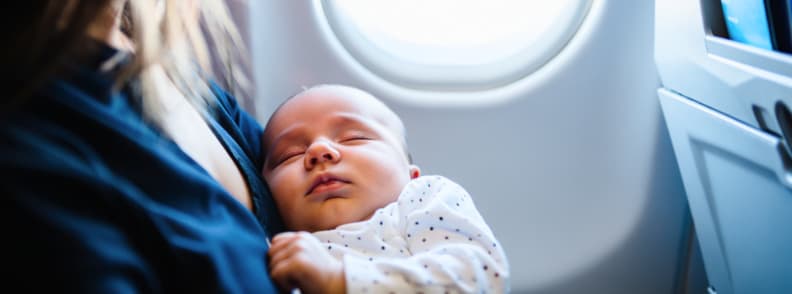
Flying With an Infant or Toddler. How to Survive Flying With Baby
I’ve done flying with baby more than once, from a flight from Nice to Bucharest when he was just five months old to another nearly a year later, when he could walk, point at cabin lights, and absolutely refuse to stay still. There’s no single trick that makes it easy, but knowing the infant flight rules, your options for seating, and how to manage in-air needs will change your entire experience.
Understanding Your Options: Lap Infant vs Paid Seat
If it’s your first time, start by learning the basics of flying with a lap infant cost. On most airlines, children under 2 fly free or nearly free if they sit on your lap. But that doesn’t mean you’ll avoid every charge.
- Lap infant rules differ by airline. Some allow advance seat selection or early boarding. Others make you pay for those perks.
- On international routes, the infant in arms fee is often 10% of the adult fare plus taxes.
- If you want more space, book a second seat and bring an FAA approved car seat for airplane travel. It’s safer and far more comfortable for longer flights.
So far, flying with the infant in arms was fine. But now that he’s become mobile, I am thinking of the added benefits of having that extra seat to handle flying with toddlers better.
Choosing Your Seat: When the Airline Bassinet Helps
Many long-haul carriers offer an airline bassinet, but you need to request it in advance, often by phone, not during online check-in.
- These are usually mounted to bulkhead walls and suit babies under 11 kg (around 24 lbs).
- Some airlines charge to reserve the bulkhead. Even on cheapest airlines for lap infants, there may be a seat-selection fee.
- They’re ideal for babies under 8 months who don’t yet roll. If your baby is older, or big for their age, or has developed the skill to roll, then skip it and use a wrap or carrier.
Airport Security and Onboard Logistics
Getting through airport security with baby and stroller sounds stressful, but it’s usually manageable with prep.
- You can wear your baby through security in a baby carrier travel sling. Depending on the airport, they might not ask you to remove the carrier.
- Gate-checking your travel stroller lets you use it through the airport and pick it up right at the aircraft door. It’s extremely useful in airports that don’t provide strollers for small children.
Onboard:
- Pack a diaper bag travel setup with zip pouches: one for nappies and wipes, one for clothes, and one for snacks and distractions.
- Airplane diaper change logistics are rough. Some toilets have fold-down tables, but they’re narrow and often dirty.
- I’ve seen parents who had to change their babies in the aisle. It’s not ideal, but if the toilets are in poor shape/too unsanitary to take your baby inside, sometimes it’s the only option you’re left with.
Managing Ear Pressure and Fussiness
One of the hardest parts of flying with an infant is dealing with baby ear pain plane symptoms. During take-off and landing, the pressure changes fast, and babies can’t equalise like we can. You’ll usually notice them tugging at their ears or crying without warning.
- Breastfeed or give a bottle as the plane ascends or descends. Swallowing helps reduce baby ear pain plane and naturally relieves pressure.
- If you’re past the bottle-feeding stage, a pacifier works too.
- For some toddlers, baby noise cancelling headphones help with general sound overload, especially in the cabin during announcements or turbulence.
- Gentle rubbing behind the ears or along the jawline has also worked for us on shorter flights.
Baby Plane Travel Tip: If your baby’s already overtired when boarding, the pain tends to feel worse. Try to feed or soothe before the engines roar.
How to Keep Baby Entertained on a Long Flight
You don’t need a suitcase of toys. But you do need a plan.
- I pack 3-4 best baby travel toys for flights: soft books, sensory pouches, one small puppet.
- For older infants, reusable window stickers and fine motricity toys keep hands busy.
- Aisle walks are your friend. I did laps from row 22 to the back galley more than once.
Parent Travel Tip: If your baby naps well in a carrier, don’t mess with success. Wear them, pace the aisle, and let them sleep through turbulence.
Flying is rarely fun with a baby, but it is possible. Plan ahead, accept a few surprises, and focus on what keeps you calm. Because when you’re steady, your baby feels it too.
Next, we’re tackling long road trip baby drives, including how to time stops, keep food clean, and survive the back seat.
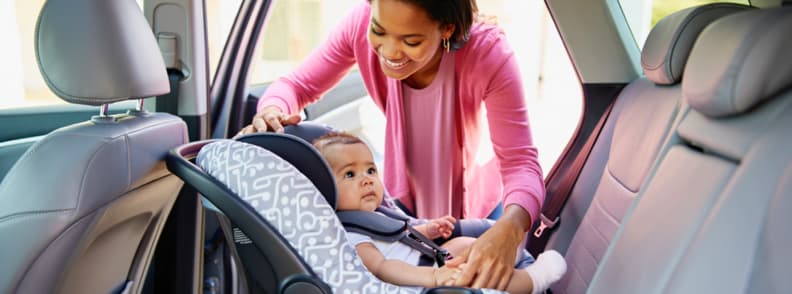
Road-Trips & Camper Life: How to Master a Road Trip Baby Setup
Some of our best memories were made on wheels. We took our baby on his first road trip baby loop, when he was just four months old, touring France by camper to meet my husband’s extended family. We’ve done multiple long drives since, including overnight stretches and slow scenic routes. What made the biggest difference? Timing, comfort, and accepting that not every kilometer would be smooth.
Timing Is Everything, So Drive When Baby Sleeps
If you take just one thing from this section, let it be this: drive during naps. It’s the single best move we made on our first long loop around France. I planned feeds and diaper changes around his usual nap schedule, then timed our departure so that he’d fall asleep naturally once the engine started.
We learned this the hard way. On our first long trip, we left home in the evening, thinking he’d sleep. Instead, we wrecked his rhythm, and he cried until we found a safe place to stop, and I could take him in my arms.
Now we leave early morning or post-nap, never in the evening. That one change saved us hours of stress.
Packing Right for the Drive
Every parent’s road trip baby list is a little different, but ours always includes:
- A stocked diaper bag travel setup with nappies, wipes, a change pad, clothes, food, and distractions
- Full water bottles (for us and the baby if they’ve started drinking water)
- Easy-access toys clipped to the seat. Soft toys while on the road, for safety reasons
- A well-fitted travel car seat installed at the right angle.
Road Trip Baby Hack: If your baby uses a baby carrier travel sling, pack it near the door. It helps with quick rest-stop walks and calms them after long stretches in the seat.
Managing Breaks and Baby Care on the Road
Try to stop every 2-2.5 hours, even if your baby is still asleep. They need time out of the seat for physical health, not just fuss prevention.
- Look for baby friendly road trip stops, such as shaded picnic areas, quiet supermarket car parks, or grassy rest zones.
- Avoid high-traffic fuel stations. They’re overstimulating, and the toilets are rarely baby-friendly.
- Diaper changes in the backseat or on a travel mat work well when you can’t find full-size changing tables.
When we’re in France, we find frequent, reliable baby road trip stops along the highways: clean toilets outside school holidays, safe parking, a bit of shade, and space to stretch. If you’re planning a longer route, build in flexibility for meals, feeds, and impromptu nappy changes. The best baby road trip stops are the ones that help everyone reset, not just refuel.
When planning your route, build in margin for delays. One blowout, missed turn, or roadside feed can set you back 45 minutes. That’s normal. Don’t rush.
Motion Sickness and Car Seat Tips
Some babies may struggle with nausea in the car, especially around 6-12 months. Ours didn’t, but if yours does, here’s what experienced parents suggest:
- Use breathable clothing and shade covers to prevent overheating
- Keep windows cracked slightly for airflow
- Offer water regularly and avoid feeding right before a steep or winding stretch.
If your child is prone to it, talk to your pediatrician about motion sickness baby remedies safe for their age. Some recommend ginger powder on socks or very mild herbal teas, but my advice is to always ask the medic first.
Don’t pack tight around the travel car seat. Let air circulate and give them room to wiggle safely.
Road trip baby travel can be deeply rewarding. You set the pace, stop when you want, and build routines into the rhythm of the road. Just stay flexible, start slow, and always pack more wipes than you think you’ll need.
Next up, we’re navigating train travel baby trips, and long-distance bus routes, plus how to handle strollers, snacks, and solo parenting on public transport.
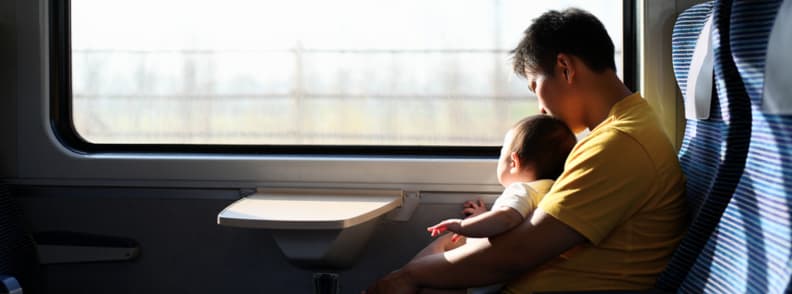
Stress-Less Tips for Train Travel Baby and Bus Journeys
We haven’t done a train trip with our son yet, but I’ve researched it extensively and swapped stories with other parents across Europe. Whether it’s a scenic ride through the Alps or a city-to-city dash on a budget carrier, train travel baby and bus travel baby experiences come down to smart booking, smart packing, and lower expectations. You don’t need to avoid public transport, just prep differently.
How to Book and What to Know Before You Board
Start with the rules. If you’re in the US, Canada, or Europe, you’ll find big differences in how babies travel on public transport.
- Many parents ask: are babies free on trains? The answer is usually yes, babies under 2 can travel for free on most regional and long-distance trains as lap infants. But it’s not automatic.
- Even if babies are free on trains, you often still need to register them on the ticket or booking confirmation.
- If you want your own seat, even with a baby on your lap, you may need to pay a nominal fee.
- To book correctly, look for the option to book infant ticket on Amtrak or equivalent. In France, the SNCF lets you add babies for free. In Germany, Deutsche Bahn does too, but only if they’re listed during booking.
- Some train operators (including Amtrak infant ticket policies) let you bring a car seat for use on board if you purchase a separate seat.
Baby Train Tip: Print or save your ticket and policy in case of conductor disputes. Not every route has consistent staff knowledge about rail infant ticket rules.
Know the Operator Rules, Discounts, and Policies
If you’re looking to save money, Amtrak baby discount rules are good to know ahead of time. Children under 2 ride free on a lap with an adult, but aren’t guaranteed a seat. To use your FAA approved car seat for airplane travel on board, you’ll need to book their own seat.
- Most European train lines also allow stroller storage on trains, but space varies by train class.
- On long-distance coach carriers like FlixBus or Greyhound infant policy, babies must have their own seat with an approved car seat. You can’t hold a lap baby on board.
- Quiet cars are not always family-friendly. In France or Italy, book family-designated seating if available instead of a quiet car.
Baby Travel Tip: If you’re traveling on a night train, choose a private cabin. That way, late-night feeding or crying won’t bother others.
What to Pack for the Ride
Train travel gives you more freedom to move than planes do, but you still need to pack smart. Here’s what to include for a solid train travel baby setup:
- Small backpack with nappies, wipes, and a thin portable mat
- One comfort toy or book, ideally attached to the seat or window
- Pre-portioned snacks in leakproof containers
- Layers, because cabins fluctuate in temperature more than expected
For bus travel baby trips:
- Use a compact baby carrier travel sling for boarding
- Bring a window shade or muslin to block sunlight if seats lack curtains
- Line the car seat with a towel for spills and accidents
- Expect fewer breaks. Change diapers before you board.
Managing Time and Space On Board
Trains are perfect for aisle pacing, especially if your baby’s fussy. On longer routes:
- Alternate between holding, window time, and walks
- If the route is scenic, snag a window seat and keep your baby forward-facing. Babies love movement!
- Use time stops to give them a change of scenery, even just standing on the platform.
Parent Advice: Don’t overpack. You’ll have to carry your baby and your bags during boarding and transfers. Prioritise a lightweight setup over a full gear haul.
Train travel baby trips can be some of the most relaxing if you plan the right connections and give your baby chances to reset. Buses are less flexible but still manageable if you book the right gear. Keep your expectations realistic and your snacks reachable.
Next, we’ll cover ferry travel and short-hop boats. Find out how to manage open decks, anchor naps, and boarding logistics when traveling with a baby by sea.
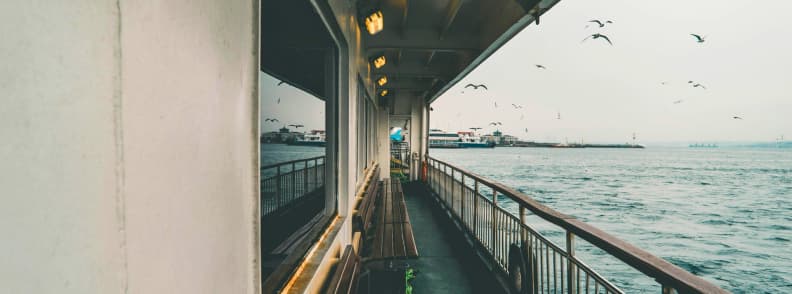
Ferry & Short-Hop Boats: Sailing Smoothly When Traveling With a Baby
We haven’t taken a ferry with our baby yet, but after sailing the Mediterranean, I’ve watched other families handle boat life with grace and calm, and picked up more than a few smart tips from them. I’ve learned that babies learning to walk on a boat struggle to find their land legs afterward, and I’ve seen infants rocking peacefully in a sling at anchor in a rugged bay. If you’re planning ferry travel baby crossings, or short coastal hops, the key is knowing how to prep for motion, naps, and weather.
Planning for Safety and Timing Before You Board
Timing matters. Babies feel the bumps more than we do. Choose calmer crossings whenever possible.
- Always check ahead to confirm whether your ferry has cabins, lounges, or just open seating.
- For longer routes, try to book a ferry cabin baby setup. These offer space for feeding, changes, and naps.
- On short routes, especially in summer, sit near shaded windows or inside lounges. Avoid windy top decks unless your baby loves movement.
Baby Travel Hack: The best time for ferry travel baby crossings is usually early morning when seas are calm and terminals are quiet.
What to Pack and How to Carry It
You won’t want to be dragging multiple bags onboard. I recommend a single backpack with:
- Nappies, wipes, and a travel mat
- Light layers for your baby. Even hot weather can feel cold on open decks.
- A baby carrier travel sling so you can keep hands free and move safely
- One comfort item (soft book or lovey).
If your route allows, bring a compact travel stroller that folds fast and fits between seats. If not, leave it in the car or skip it entirely.
Naps and Movement to Help Baby Adjust Onboard
Many babies sleep beautifully with the vibration and hum of the engine. Others may need help adjusting. Here’s what I’ve learned from fellow parents at sea:
- A quiet corner of the lounge or cabin works best for nap time.
- The rhythm of the water can calm babies, but too much wind or noise can make them restless.
- You can rock your baby gently in a sling while walking on deck. Use railings for stability.
If you’re on foot and taking your baby without a cabin, know that most lounges don’t have official changing areas. Bring your own mat and use discreet corners when needed.
Ferry Travel Baby Tip: If your baby is fussy, take a walk toward the back of the boat. It’s often quieter there, and the motion is more consistent.
Final Tips for Smooth Sailing
- Always check safety policies. Lifeboats don’t have infant-size life vests on every vessel. Bring your own if required.
- If you’re boarding by foot, check whether stroller on ferry is allowed. Some operators restrict them on gangways.
- Keep baby’s snacks and milk in a small cooler bag. Ferries usually don’t offer baby-friendly food.
And one last thing: if your child has already started walking, they’ll want to move. Stay close, use railings, and avoid stairs.
With planning and flexibility, ferry travel baby trips can be as peaceful as a nap in your arms. Some of the calmest babies I’ve ever seen were swaying gently in a sling at sea.
Next up: cruise, glamping & RV travel with a baby, including nursery policies, campground safety, and how to baby-proof the most unpredictable places.
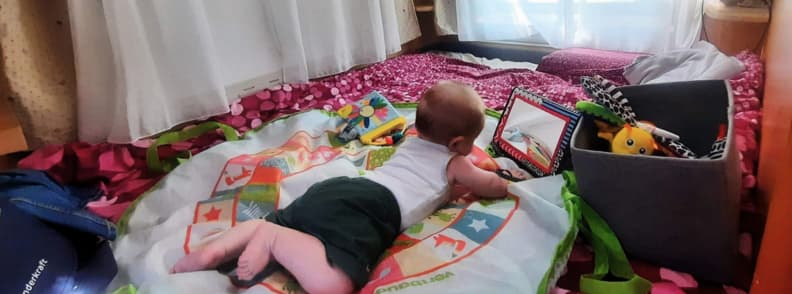
Cruise, Glamping & RV Travel With a Baby
These types of slow travel trips give you the most control. For us, they’ve also been the most rewarding. We’ve taken our son on multiple camper trips, and while we haven’t yet gone on a cruise with him, I’ve met plenty of families at sea who swear by it. I’ve also kept an eye on baby travel friendly glamping spots across Europe, and the appeal is real: soft beds, no tents to pitch, and space to roam. Whether you’re booking a week in an RV, testing a yurt in the countryside, or sailing off with baby on board, this is what you need to know.
What to Ask Before You Book a Cruise With Baby
Cruises can be baby-friendly, but policies vary by cruise line. Start by checking the minimum baby age for cruise. It’s usually 6 months, but some lines require babies to be at least 12 months for ocean crossings or cruises with more than two days at sea.
Look for baby friendly cruises that include:
- Onboard cruise nursery age limits appropriate for your baby
- Quiet cabin locations away from the late-night crowd
- Family-friendly excursions with no mandatory walking tours.
If you’re bringing a stroller, opt for one that folds easily and fits through narrow cabin doors. And bring a portable blackout shade if your baby is used to dark sleeping spaces.
Cruise With Baby Tip: Use sea days for downtime. Parents I spoke with said their babies handled the trip best when the days were predictable and not over-scheduled.
What to Know About Baby Gear at Sea
Not every ship will provide what you need. Ask about:
- Baby cruise gear rental options (some lines offer cribs, high chairs, or steriliser access)
- Laundry facilities and whether detergent is provided
- Milk and food access. Buffets are not always baby-friendly.
Pack backup food pouches and familiar snacks. You might not find what your baby eats at home. If you’re still nursing, ask about private spaces for breastfeeding discreetly. Not because there’s something wrong with breastfeeding in public, but it may be too distracting for your baby to breastfeed efficiently. Many ships also offer quiet areas that work well.
RV Travel Baby Tips From the Road
Camper travel gave us space, nap flexibility, and a fridge for fresh food. But it also came with its own learning curve. On our first long trip (our version of a Tour de France in a motorhome), we realized quickly that RV baby sleep routine can fall apart fast if you push bedtime too late or start the engine at the wrong moment.
- Choose your departure time around nap windows, not arrival times.
- Pre-load the camper before waking your baby to keep transitions calm.
- Stick to your usual wind-down rituals as much as possible.
RV travel baby days worked best for us when we slowed down. We’d stop for walks, use the same bedding from home, and take breaks to reset.
What to Pack and Expect When Glamping With Baby
Glamping with baby sounds fancy, but it’s often just rustic enough to be tricky with little ones. That’s why I always prepare for variable conditions.
- Ask ahead about crib availability, temperature control, and water access.
- Many baby travel friendly glamping spots offer small kitchenettes. Bring your own sponge and dish soap for bottles or baby utensils.
- Keep gear simple: a mosquito net, soft lighting, and a play mat are usually enough.
Campground babyproofing tips include padding sharp corners, covering outlets, and sweeping floors daily for rocks or dirt babies love to find.
Glamping With Baby Tip: Use your baby carrier travel sling to get around rough terrain. It saved us countless stroller struggles.
Whether you choose a cruise with baby, an RV travel baby route, or a few quiet nights glamping with baby, the key is consistency. Keep the pace slow, pack only what you’ll use, and build your baby’s routine into the rhythm of the trip. These are baby-friendly holidays in their own right.
Now let’s discuss sleep and jet-lag by age, including nap survival, routine protection, and how to help your baby adjust to time zones when traveling with a baby.
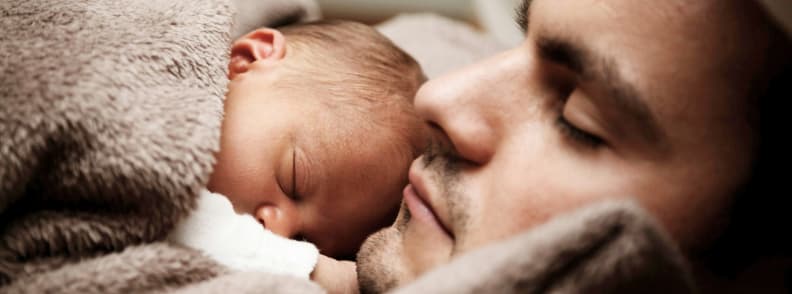
How to Protect Rest When Traveling With a Baby
Sleep is the first thing that gets messed up when you travel. And for a long time, I thought we had to rebuild a new routine from scratch in every place we visited. We don’t. After enough trips by car, camper, and plane, I’ve learned how to hold on to our rhythm, even with time zone shifts. Whether you’re planning a short road trip or crossing borders by air, this is how I manage baby sleep travel and ease the transition for both of us.
Stick to Your Home Routine, Wherever You Go
The most helpful advice I ever got? Don’t invent a new bedtime just because you’re in a different place. Keep things familiar.
- I use the same sleep sack, white noise, and pre-nap song wherever we go.
- We follow the routine from home. Same order, same timing. That helps him feel secure.
- It worked in the camper. It worked in hotels. And it worked when we flew to Bucharest.
The real challenge is figuring out how to manage baby sleep while traveling without losing your mind. The answer isn’t to copy every step perfectly but to keep the signals clear. Your baby needs to know when sleep is coming, even in a new environment.
Baby sleep travel isn’t about getting it perfect. It’s about staying consistent with what already works. If your baby falls asleep after a feed and a lullaby at home, do the same, even if you’re parked under pine trees or staying on a noisy street.
Baby Sleep Travel Tip: Bring a blackout cover or hang a scarf over a curtain rod to darken the space if needed. A dark room is still your best ally.
Keep the Baby Sleep Schedule While Traveling Simple
Your baby sleep schedule while traveling doesn’t have to change much. I let the new environment shape the details (naps might shift by 30–60 minutes), but I hold to the same overall rhythm.
- Morning wake-up within 30 minutes of normal
- First nap stays protected whenever possible
- Afternoon nap flexible but offered around the usual time
- Bedtime within the same one-hour window as at home.
No schedule will survive a delayed flight or a missed nap at a museum. But staying close to your home rhythm, especially in the mornings and evenings, helps your baby adjust faster and stay calmer.
What Actually Helps Fight Baby Jet Lag
One of the most searched-for concerns is baby jet lag, and I get it. It can throw off feeds, naps, and nights. But with a few adjustments, you can make it manageable.
- Stick to your existing sleep routine as much as possible, even if your baby wakes up at odd hours.
- Spend plenty of time outside during daylight. Natural light helps reset circadian rhythms.
- Shift the schedule slowly by 15-30 minutes per day if you’re preparing before the trip.
I don’t change anything before we leave. We travel, land, and fall back into our routine. He takes care of the rest on his own, slowly adapting. That works for us. If you’re changing more than 3 time zones, try easing into it across a few days.
Minimize Jet Lag for Baby With Smart Choices
Yes, you can minimize jet lag for baby, but it starts before take-off.
- Book flights that land in the afternoon or early evening, not the middle of the night.
- Let your baby nap on the plane, but wake them gently when you arrive to get them used to the new time zone.
- Offer extra feeds during transition days. They’re soothing and help with hydration, especially after long flights.
Jet lag tips for babies flying east include pushing bedtime a bit later the day before you leave and keeping the next morning relaxed. Don’t pack the first 24 hours with activities. Just let the baby adjust at their own pace.
Baby Jet Lag Advice: You might be tired too. Stick close to your hotel or campsite that first day and let everyone catch up.
Baby Sleep Travel by Age Group
Here’s what I’ve seen at each stage:
| Age | Sleep Travel Notes |
|---|---|
| 0–5 months | Easy to transfer and nap on the go. Protect naps with motion (carrier or stroller). |
| 6–12 months | Nap routines matter more. Expect some resistance with new environments. |
| 12–24 months | They remember the room and expect consistency. Bring comfort items and wind down fully before bed. |
Whether you’re in an apartment, a tent, or a ferry cabin, baby sleep travel depends less on gear and more on familiarity. Keep your core cues in place, and your baby will settle, even if bedtime is a little later than usual.
Now let’s discuss health, hygiene & first-aid toolkits, covering vaccines, travel illnesses, and what I pack to feel ready for anything when traveling with a baby.
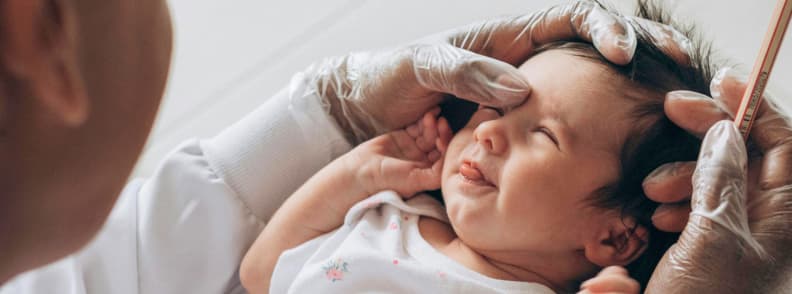
Staying Healthy, Safe, and Sane While Traveling With a Baby
There’s nothing more unsettling than being far from home with a baby who doesn’t feel well. I’ve had trips with no issues and others where we battled minor rashes, teething pain, and questionable food-induced tummy troubles. You don’t need to pack an entire pharmacy, but a solid kit, up-to-date vaccinations, and a flexible mindset will get you through most situations when traveling with a baby.
Vaccines & Travel Illness: What to Ask Your Pediatrician Before You Go
Your baby’s regular jabs cover a lot, but international travel sometimes adds extra risks. Always check destination requirements well in advance.
- Ask your GP or pediatrician about baby travel vaccinations based on your destination’s risks.
- The CDC travel vaccines for infants list is a good starting point for US-based travelers. In Europe, ask your local provider or check ECDC advice.
- Additional baby travel vaccinations may include hepatitis A, hepatitis B, typhoid, or even yellow fever, depending on where you’re headed and your baby’s age.
- If you’re unsure about timing, schedule a pre-travel health check four to six weeks before departure.
Baby Travel Vaccinations Tip: Bring printed vaccine records with you. If your baby gets sick abroad, doctors will ask for this first.
What to Pack in Your Baby Travel First Aid Kit
I pack light, but our baby travel first aid kit always comes with us. Here’s what’s inside:
- Infant paracetamol and oral syringe
- Teething gel or rings
- Digital thermometer
- Saline in small plastic vials with rounded tips
- Travel-sized antiseptic and bandages
- Hand sanitizer (baby-safe formula).
Optional extras I’ve found useful: electric nail file, bug repellent wipes, and a mild baby lotion in dry climates.
Baby Travel First Aid Kit Advice: Label everything. Airport security sometimes checks liquids; having them clearly marked as medicine speeds things up.
Common Concerns and Smart Preventatives
Baby travel sickness can happen more than once per trip. Motion, fatigue, and sudden changes in routine all play a role.
- Plan short stretches of transport when possible, especially after meals.
- For baby motion sickness remedies, some parents use ginger socks or peppermint balms, but check with your doctor first.
- Keep the car cool and offer sips of water regularly. Avoid feeding heavy meals right before travel.
When things go wrong, hydration and calm matter more than anything. Most baby travel health issues are short-lived if you catch them early and avoid overreacting.
Do You Really Need Baby Travel Insurance?
Yes. Always. Baby travel insurance should cover:
- Emergency medical care
- Travel delays or cancellations
- Coverage for a parent escort if hospitalization is required
- Loss or delay of essential baby items (stroller, car seat, medication).
If you already have travel insurance for family with infant, double-check that your baby is actually named on the policy. Many companies require that infants be registered individually, even if the coverage is family-wide.
Baby Travel Insurance Tip: Some premium credit cards offer automatic baby travel insurance when booking with the card. Confirm what’s included before relying on it.
Hygiene Essentials for Every Destination
Clean hands and clean feeding gear are your first line of defence.
- I always carry sanitizer for baby travel, usually a baby-safe, alcohol-free gel in a clip-on bottle on my nappy bag.
- I pack extra muslins, cloths, and a roll of biodegradable bags in my day bag.
- In rural areas or outdoor destinations, I bring a waterless wash and sanitizing wipes, essential if the baby drops a toy or touches every surface in sight.
- In cities, I lean on public toilets with changing facilities, but always carry a portable mat.
Baby Travel Tip: Don’t forget sunscreen and baby-safe insect repellent. Even short park visits can bring exposure you weren’t expecting.
Let’s move on to entertainment & comfort and discover how to keep your baby relaxed, distracted, and happy in transit, with your own sanity intact.
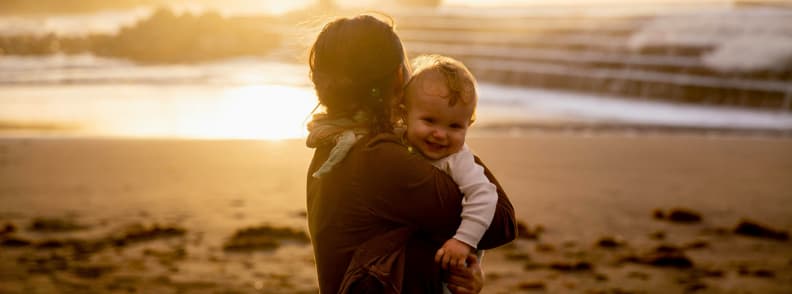
How to Keep Everyone Happy When Traveling With a Baby
You don’t need an endless bag of distractions to survive a long day in transit. But you do need to think ahead. Babies get bored quickly in tight spaces, and tired parents lose patience even faster. This section walks you through what works to comfort, soothe, and entertain your baby when you’re far from home, without adding clutter or stress.
Toys That Work Anywhere
We’ve tested a lot. The ones that helped the most were simple, quiet, and multi-use. When packing best baby travel toys for flights, I look for:
- Lightweight sensory toys airplane safe for mouthing and easy to clean
- Clip-on rattles that double as stroller distractions
- A compact busy board travel set with zips, buttons, and flaps, ideal for hands-on play during long waits
- Window clings or reusable stickers for flights and trains
- Compact toys that fit in zip pouches inside your diaper bag travel kit.
Everything fits into one zippered pouch, no batteries required. The sole exception is our story box, used when we can’t bother other passengers. I usually bring just 2-3 toys total, rotating them through the trip.
Baby Travel Tip: Don’t hand out all the toys at once. Save one for when your baby hits peak fussiness. It feels new again.
Aisle Walks and Reset Moments Because Movement Matters
When babies are stuck in one spot for too long, it shows. Whether you’re on a plane, train, or ferry, pacing helps.
- On flights, I take short aisle walks with baby, especially between meal service. The hum of the cabin plus the motion often calms him down.
- On trains, open vestibules or empty doorways allow mini stretches.
- Even on road trips, we stop for quick walks outside the camper. A five-minute reset can turn the whole day around.
I’ve walked dozens of laps on flights to Bucharest and back. He didn’t nap, but he stayed calm. That was enough.
Soothing Tools and Calming Tricks
Calming a baby mid-transit is different than at home. There’s noise, movement, and no escape room. The trick is to stick with familiar cues and stay calm. My go-to soothing techniques for fussy baby travel include:
- Gentle motion: walking, rocking, or swaying in place
- White noise through an app, the natural hum of the engine, or me saying Om, if the space allows it. The latter also makes my chest vibrate when I hold him so it works well.
- Familiar baby comfort items. We always bring his Ikea owl and a backup in case it gets dropped.
- Pack extras. If your baby drops their pacifier, you’ll want a clean one ready fast.
- Use baby noise cancelling headphones if your baby is sensitive to sound. These can help on flights when announcements can startle them out of naps.
Sometimes it takes ten minutes. Sometimes it takes two. But the sooner I respond to early signs of fussiness, the easier it is to reset.
Parent Travel Tip: Don’t hesitate to find a quiet space, even if it means stepping away from the group. Babies regulate faster when their environment calms down. You can even do skin-to-skin cuddles in a quiet corner of the airport or back row of the train.
How to Keep Baby Entertained on a Long Flight
This is one of the most common questions I hear: how to keep baby entertained on a long flight? My answer is simple: keep it moving, keep it quiet, and keep it slow.
- Rotate toys every 30-45 minutes.
- Offer snacks or feeds in between.
- Narrate your actions. Just talking through what you’re doing holds their attention longer than you’d think.
Baby Travel Tip: Use window seats for play zones. Let them peek outside, stick up a toy, or play peekaboo with the shade.
Parental Sanity: Don’t Forget About Yourself
It’s easy to focus only on the baby. But you matter too.
- Pack one thing just for you, such as a snack, a magazine, or noise-cancelling earbuds.
- Hydrate often. I bring a bottle I can refill at airports or stops.
- Accept help when it’s offered. Someone holding a door or lifting your stroller isn’t judging you. They’re just being human.
When you’re calm, your baby feels it. That mindset (steady, grounded, low-stress) is sometimes the best travel tool you’ll bring.

Baby-Friendly Destinations & Accommodation: Where to Stay and What to Look For When Traveling With a Baby
Not every hotel, resort, or city is built with babies in mind. Some are loud, cluttered, or frustrating from the minute you check in. Others are quiet, clean, and genuinely make things easier. I’ve stayed in all types, and while none stood out yet, I’ve learned exactly what to look for when choosing baby friendly hotels, baby friendly destinations, and even baby friendly restaurants.
What Really Matters When Booking Baby Friendly Hotels
A cot in the room isn’t enough. When I scan listings for baby friendly hotels, I always check for:
- Lift access or ground-floor rooms if I’m bringing a travel stroller
- Kitchenette or microwave access for heating milk or food
- Proper blackout curtains for nap protection
- Quiet location away from clubs, traffic, or crowds.
Some baby friendly hotels with cribs will set up a cot before you arrive. Others just mention crib on request and then don’t deliver. Unless you’re bringing your own baby crib from home for familiarity, always email ahead and confirm in writing.
Baby Friendly Hotels Tip: If the website says family friendly, that usually means older kids. Look specifically for infant amenities or photos of babies in the gallery.
Choosing Baby Friendly Resorts and Rentals
The best baby friendly resorts offer space and routine-friendly setups.
- Pools with shade and shallow splash areas
- Restaurants with high chairs and early meal times
- Stroller-accessible paths and ramps.
If we stay in an Airbnb or holiday rental, I bring basic babyproofing gear, such as corner covers, door stoppers, outlet covers. I also ask for photos of the kitchen and sleeping area layout.
In baby friendly destinations, we prioritise walkability, accessible green spaces, and a short travel time from airport or train station to accommodation.
Exploring Baby Friendly Cities and Attractions
You can still explore culture with a baby, if you pace yourself and choose the right spots.
- Baby friendly museums often have lifts, family rooms, and pram-accessible layouts
- Baby friendly parks give you breathing space between sightseeing stops. Look for fenced play areas or soft ground for crawling.
- Baby friendly attractions usually mean those with no long queues, no strobe lights, and no loud audio guides.
Baby Travel Tip: Check local parent forums or blogs for hidden gems. The best baby friendly tours are often the ones run by small businesses who welcome families on their own terms.
Eating Out in Baby Friendly Restaurants and Meal Planning
Eating out with a baby takes planning. Look for baby friendly restaurants with:
- Space for a pram
- High chairs that are actually clean and safe
- Flexible staff who won’t rush you out.
We avoid fine dining and go for casual bistros, cafés, or bakeries where food comes quickly and outdoor seating is available. If in doubt, I ask locals at a park or playground where they take their kids to eat.
I also carry a pouch of food, water, and a soft spoon for every sit-down meal. Not every place will have options for babies, and that’s fine if you’re prepared.
Best Destinations for Traveling With a Baby
The best destinations for traveling with a baby aren’t always the ones with the most attractions, they’re the places that let you slow down, walk safely, and reset when needed.
Here’s what I look for when choosing where to go:
- Mild weather and clean air (not too hot, not too humid)
- Short transfer times from airport or station to your accommodation
- Easy access to baby friendly parks, cafés, and grocery shops
- Safe pedestrian areas or public transport that allows travel stroller use.
Examples parents often mention:
- Copenhagen (wide sidewalks, clean public spaces, and changing tables in cafés)
- Ljubljana (compact, calm, stroller-friendly, and riverfront paths)
- The Basque Coast of Spain (shady beaches, family-first restaurants, local playgrounds everywhere).
We haven’t found our favourite yet, but anywhere with time, space, and a bit of quiet often feels like a win. I’d rather go somewhere simple and enjoy it fully than tick off a high-stress must-see city just to say we’ve been.
Parent Travel Tip: If you’re flying for the first time, aim for a destination with direct flights and a two-hour time difference or less.
Building Your Own Baby Friendly Travel Days
Once you’ve chosen a base, plan short, flexible days:
- Mornings for museums or indoor visits
- Afternoons for baby friendly beaches or quieter green spaces
- Evenings at your accommodation or a relaxed early dinner spot.
Parent Travel Planning Advice: Don’t overpack the itinerary. One solid activity in the morning and a calm afternoon is more enjoyable than ticking boxes and stressing over naps.

Paperwork, Proof, and Peace of Mind When Traveling With a Baby
Paperwork is no one’s favorite part of family travel, but it matters. Whether you’re flying abroad, crossing borders by train, or simply checking in to a hotel, you’ll need the right documents for your baby. I’ve learned to prep everything in advance and keep both digital and hard copies in a single folder. This section walks you through what you’ll need, where to get it, and what to expect.
Baby Passport and Application Tips
If you’re going abroad, one of the first things you’ll need is a baby passport. Even newborns must have their own.
- For how to get baby passport quickly, start by booking an appointment as soon as travel is confirmed. Some countries offer expedited service, but you’ll need proof of urgency like flight tickets.
- For the baby passport photo, schedule it for a time when your baby is calm. Right after nap time worked best for us.
- Bring your baby’s birth certificate, both parents’ IDs, and proof of address.
Baby Passport Photo Tip: Some photo studios specialize in infant passport photos. It’s worth every cent if you want it done right the first time.
Documents Required for Baby International Travel
The question comes up constantly: international travel with baby documents needed —what’s essential?
Here’s what we always bring:
- Baby passport (original, not a copy)
- Copies of vaccination records (especially if crossing continents)
- A child travel consent letter if one parent is not present. Some countries require it to be notarized, while others have specific forms.
- Proof of accommodation or return ticket
- Emergency contacts, printed.
Check each airline’s and country’s policies in advance. International travel with baby documents needed vary by route and passport type.
Baby Travel Tip: Keep all documents required for baby international travel in a waterproof folder in your carry-on. You may need to show them more often than you think.
Travel Insurance Forms and Policy Notes
Double check that your travel insurance for family with infant covers:
- Medical emergencies
- Delays or cancellations
- Baby gear loss or damage (like travel stroller or travel car seat)
- Repatriation, if needed.
Some policies don’t include babies automatically, so make sure your child is named in writing. I always carry a printed version of our policy summary and emergency numbers.
Proof of Guardianship and Solo Parent Travel
Some border agents will ask for travel proof of guardianship, especially if only one parent is traveling or the baby’s surname is different.
- Bring a notarised child travel consent letter signed by the other parent
- Include contact info and a scanned copy of their passport.
- Bring copies of your baby’s birth certificate and both parents’ passports
- For shared custody, bring supporting documents like court orders or agreements
Parent Travel Advice: Border agents are more strict than airline staff. Even if the airline checks nothing, immigration might.
Customs Declarations for Baby Essentials
Cross-border rules can be strict, especially for liquids, powders, and perishables. Here’s how to handle customs declaration for baby food and supplies:
- Check local rules before bringing in baby food, especially dairy or meat-based pouches
- Some countries limit powdered formula, or ask you to show a doctor’s note
- Always pack items in their original packaging to avoid confusion.
For meds, including baby travel first aid kit supplies, carry the prescriptions if possible. Even over-the-counter meds can be questioned if you’re bringing more than one bottle.
Flying With Baby Advice: In some countries, even baby wipes count as controlled liquids over a certain volume.
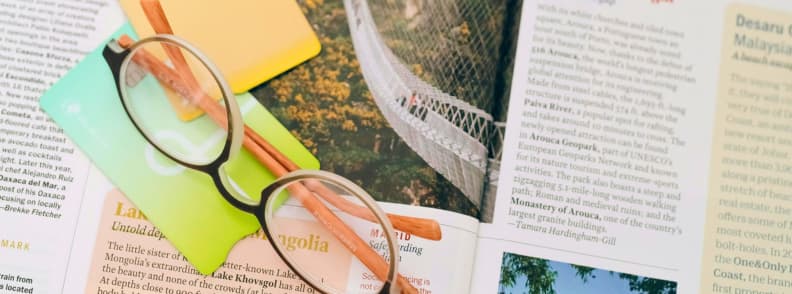
Saving Money While Traveling With a Baby With Budgeting/Rewards
Having a baby doesn’t mean you have to pause travel, but it does mean your budget will shift. Between gear, extra baggage, and emergency costs, expenses add up fast. We’ve travelled as a family on a tight budget more than once (across France by camper, to Bucharest by plane, and back again by car) and learned how to stretch our spending without sacrificing comfort or safety. Here’s how we manage our baby travel budget and make the most of every trip.
Hidden Costs of Baby Travel
Some expenses are obvious, others sneak up on you. Here are the most common hidden costs to watch for when managing your baby travel budget:
- Flying with a lap infant cost. Even if your baby flies free domestically, international airlines usually charge 10 percent of the adult fare plus taxes
- Infant flight rules may allow free checked items, but cheapest airlines for lap infants often charge for bassinets, seat selection, or priority boarding
- Some hotels charge extra for cots or early check-in, even when listed as baby friendly hotels
- Rental car companies may charge a high daily rate for a travel car seat, even if it’s poor quality.
We now bring our own gear and choose accommodations that confirm baby items in writing.
Comparing Gear Rental vs Buying Your Own
When choosing between gear rental vs buying, I ask three things:
- Will I use it more than once?
- Can I pack it easily?
- Can I trust what the rental provides?
We always bring our own travel stroller and travel crib, because they’re clean, familiar, and reliable. For short stays, I’ll rent a high chair or toys locally if available. But if the gear is safety-critical, I bring it.
Baby Friendly Resorts Tip: Ask your accommodation if they partner with rental agencies for baby travel gear. Sometimes it’s included in your stay.
Best Travel Rewards Cards for Families With Infants
If you’re flying more than once a year, choose one of the best travel rewards cards for families with infants. These often cover:
- Free checked bags (ideal for travel car seat and diaper bag travel)
- Early boarding and airport lounge access (naps and feeding in peace)
- Baby travel insurance coverage when booking the full trip with the card.
Some loyalty programs free checked stroller benefits are tied to elite status or co-branded airline credit cards. Before your flight, log in and check your fare class. It may include gear allowances you’d otherwise pay for.
Budget Family Travel Hacks That Work
Some things I’ve learned that actually save money while keeping the experience comfortable:
- Stay outside the city centre. You’ll get more space and a quieter night’s sleep.
- Book direct flights when possible. Fewer connections mean fewer delays and less stress. And less food bought in airports.
- Choose self-catering accommodation. You can prep meals, boil water, and keep snacks stocked without paying hotel prices.
We’ve done a few trips now where our budget family travel total came in lower than expected, just by avoiding rushed decisions and planning snack breaks.
What to Know About Cheapest Airlines for Lap Infants
Not all airlines are equal when it comes to baby policies.
- Some of the cheapest airlines for lap infants only allow one carry-on per adult, meaning your baby travel gear counts against your bag allowance
- Others don’t include baby items in their free baggage policies at all
- Always read the fine print on lap infant rules, from seat selection fees to equipment check-in.
We fly budget often, but I now factor in total cost, not just the fare. If a €20 flight adds €100 in baby fees, it’s not the cheapest.

Staying Grounded While Traveling With a Baby
No gear, checklist, or itinerary will matter if you’re running on empty. I’ve learned this firsthand. I’ve had calm, joy-filled days on the road, and I’ve cried in the dark while my baby screamed from overtiredness. What keeps you steady as a parent makes the difference between barely coping and truly enjoying the experience. This section is for you, not just your baby.
Parent Travel Stress Is Real. And It’s Normal
If you’re feeling overwhelmed, you’re not doing it wrong. You’re just doing it.
Parent travel stress creeps in when naps don’t line up, luggage goes missing, or someone gives you a look while your baby cries at the airport. I’ve been there. So has every parent who’s ever dared to board a plane with a baby.
Part of it is logistics. But a big part is emotional, especially managing external judgment from strangers who don’t understand what you’re carrying.
What helps:
- Expect things to go off-script
- Let go of the fantasy of a “perfect” trip
- Build in buffers. Leave earlier, schedule fewer activities, pack snacks for you.
New Parent Travel Tip: Pack one non-baby item that grounds you. A tea bag, a book, music you love. Something that’s yours.
Mastering the Mindset for Traveling With Baby
Your baby looks to you for calm. The more regulated you are, the safer they feel, even if the flight is late or the room isn’t ready.
Here’s what helped me:
- I repeat my mantra: I am his rock. I am steady. I am strong for him.
- I focus on the next 10 minutes, not the full day.
- I take a breath before reacting to stress triggers.
You won’t always be Zen. I’m not. But even a small shift in mindset can change your whole day.
Parent Advice to Travel With Baby: Don’t aim to be perfect. Just be present and do your best.
Dividing Duties While Traveling With a Baby
If you’re traveling as a couple or with family, dividing duties while traveling is the secret to avoiding burnout.
- My husband and I split mornings and evenings, depending on who had the harder night.
- One of us packs the day bag, the other handles the route or booking.
- We never expect both of us to be “on” 100% of the time.
If you’re solo, the key is pacing. Choose accommodations close to what you need, and book things you can cancel without penalty. Lower pressure means fewer emotional spikes, for you and for your baby.
Asking for Help in Transit
I used to hesitate, but not anymore. Asking for help in transit is one of the most practical, powerful things you can do.
- Let the person behind you in the airport line help lift your bag.
- Ask a flight attendant to watch your seat while you take a bathroom break.
- Say yes when someone offers to hold a door, carry a stroller, or fetch water.
You’re not failing by accepting help. You’re showing your baby that community is strength. Remember it takes a village.
Self-Care for Traveling Parents
You can’t pour from an empty cup. Self-care for traveling parents doesn’t have to look like spa days or solo walks. It’s often five minutes of quiet, a warm drink, or just knowing you’re doing your best.
Ideas that work:
- Bring your own snacks and water bottle. Hunger makes stress worse.
- Dress in layers you feel good in, especially during long transport days.
- If you can, sleep when your baby sleeps, even if just for 20 minutes.
Parent Travel Hack: A supportive partner, friend, or stranger can turn a difficult day into a bearable one. Don’t underestimate how powerful a kind word can be. Give one, and receive one.

FAQ – Real Answers for Real Parents Traveling With a Baby
These are the questions I searched before every trip, and the ones parents ask me most often. Below you’ll find honest, firsthand answers. This is up-to-date, real-world information you can use right now.
What is the best time of day to fly with infant?
The best time of day to fly with infant is early morning. Flights are more likely to leave on time, airports are less chaotic, and your baby is more likely to nap. I’ve had my calmest flights when we boarded before 9 a.m., fed during take-off, and kept our nap rhythm going in the air.
Do babies need passports for international travel?
Always. Even newborns. There are no exceptions. You’ll need to apply in person, bring both parents’ IDs, and a printed baby passport photo that meets your country’s regulations.
Can babies get jet lag?
Absolutely, and you’ll feel it too. They may wake at odd times, refuse naps, or feed differently for a few days. Stick to your home routine, spend lots of time outdoors, and let them adjust gradually.
Can I bring formula through security?
Yes. You can bring formula, breast milk, and baby food over 100 ml in carry-on bags if you’re flying with a baby. Declare them at security, keep them separate, and request hand-screening if needed.
Can I bring breast pump on plane?
Yes. In most regions, a breast pump is considered a medical device and does not count toward your carry-on allowance. Check with your airline, and pack pump parts
How to gate check car seat?
To gate check car seat, bring it with you through security and request a tag at the gate counter. You’ll leave it at the aircraft door and retrieve it there after landing. Use a protective bag if you have one. This is often free of charge.
How to sterilize bottles in hotel?
To sterilize bottles in hotel, you have a few options. You can use boiling water from a kettle, if provided, bring microwave sterilizer bags (only if you know the hotel offers microwaves), or use use cold water sterilizing tablets in a sink or plastic container. I’ve done all three depending on where we stayed.
What documents do I need to travel overseas with my baby?
Here’s what documents do I need to travel overseas with my baby: baby passport, printed child travel consent letter (if traveling solo in some countries), vaccination record, travel insurance papers, booking confirmation and return ticket. Keep a printed folder and a backup copy on your phone. Paper still works best at immigration desks.
Should I buy a seat or keep baby on lap?
This depends on the length of your flight. For under 3 hours, should I buy a seat or keep baby on lap? I choose lap. For anything longer, I recommend you buy a seat and use an FAA approved car seat for airplane travel. It’s safer, more restful, and gives everyone more space.
Tips for flying with twins infants
Book seats with a third adult if possible. One parent per child works best. Choose an airline that allows two lap infants per row (some don’t). Pack two sets of essentials in separate bags. If one parent has to take a break, the other still has everything needed. Use twin carriers or two slings for security checks.
Resources & Downloads for Traveling With a Baby
Here’s where everything comes together. After packing the bags, printing the documents, and calming the pre-trip jitters, this is the corner of the guide that helps you feel a little more ready and a lot less alone. These tools, links, and templates are based on everything I’ve used or researched while traveling with a baby across France, Romania, and beyond.
Baby Travel Checklist (Printable + Customisable)
Download my complete, editable baby travel checklist, built from years of trial, error, and packing too much.
- Diapering gear
- Feeding items (breast, bottle, solids)
- Clothes and backups
- Sleep kit
- Comfort items
- First-aid kit
- Documents required for baby international travel
- What to pack in your diaper bag travel setup.
Comes in Google Sheets format so you can copy, adapt, and print it for every trip.
Baby Travel Documents Template Pack
This downloadable bundle includes:
- Child travel consent letter (solo parent format)
- Guide on how to get baby passport quickly
- Print-friendly page to log your baby travel vaccinations
- Checklist for customs declaration for baby food and meds.
These forms aren’t legal advice, but they’re solid templates to help you prepare fast.
Jet Lag Recovery & Sleep Routine Tracker
Whether you’re adjusting slowly or cold-switching time zones, use this tool to track:
- Baby sleep schedule while traveling (blank 7-day sheet)
- Nap and feed patterns across time zones
- Notes section for behaviour shifts, regressions, or breakthrough naps
- Highlight changes for each age stage: 0-5 months, 6-12 months, 12-24 months.
Airline & Policy Comparison Matrix for Traveling With a Baby
Here’s a detailed comparison of infant travel policies for the top 10 global airlines. This matrix covers key aspects such as bassinet availability, lap infant fees, loyalty programs free checked stroller, infant baggage allowances, and car seat policies.
| Airline | Bassinet Available | Lap Infant Fee | Loyalty Programs Free Checked Stroller | Infant Baggage Allowance | Car Seat Policy |
|---|---|---|---|---|---|
| American Airlines | Yes | 10% of adult fare plus taxes (international) | Yes | 1 stroller and 1 car seat checked free | FAA-approved car seats allowed in purchased seats; must meet safety standards. |
| Delta Air Lines | Yes | 10% of adult fare plus taxes (international) | Yes | 1 stroller and 1 car seat checked free | FAA-approved car seats allowed in purchased seats; must meet safety standards. |
| United Airlines | Yes | 10% of adult fare plus taxes (international) | Yes | 1 stroller and 1 car seat checked free | FAA-approved car seats allowed in purchased seats; must meet safety standards. |
| Air France | Yes | 10% of adult fare plus taxes (international) | Yes | 1 stroller and 1 car seat checked free | FAA-approved car seats allowed in purchased seats; must meet safety standards. |
| British Airways | Yes | 10% of adult fare plus taxes (international) | Yes | 1 stroller and 1 car seat checked free | FAA-approved car seats allowed in purchased seats; must meet safety standards. |
| Emirates | Yes | 10% of adult fare plus taxes (international) | Yes | 1 stroller and 1 car seat checked free | FAA-approved car seats allowed in purchased seats; must meet safety standards. |
| Qatar Airways | Yes | 10% of adult fare plus taxes (international) | Yes | 1 stroller and 1 car seat checked free | FAA-approved car seats allowed in purchased seats; must meet safety standards. |
| Singapore Airlines | Yes | 10% of adult fare plus taxes (international) | Yes | 1 stroller and 1 car seat checked free | FAA-approved car seats allowed in purchased seats; must meet safety standards. |
| Lufthansa | Yes | 10% of adult fare plus taxes (international) | Yes | 1 stroller and 1 car seat checked free | FAA-approved car seats allowed in purchased seats; must meet safety standards. |
| Etihad Airways | Yes | 10% of adult fare plus taxes (international) | Yes | 1 stroller and 1 car seat checked free | FAA-approved car seats allowed in purchased seats; must meet safety standards. |
Please note that policies can vary based on route, aircraft type, and fare class. It’s always recommended to check directly with the airline before booking.
Drop a comment if you need further details or assistance with specific airline policies.
Must-Know Links & References
These are the resources I’ve used and trust:
- TSA guidelines for baby travel. Includes TSA liquid rules for formula and medicine, can I bring breast pump on plane, and more
- CDC travel vaccines for infants
- FAA car seat guidance
- US passport application for minors
- Parents Best Baby Travel Gear Awards
Parent Travel Hack: Bookmark these before you leave. Wi-Fi in transit isn’t always reliable.
Every download and link here is designed to support your journey, whatever the destination, whatever your baby’s age.
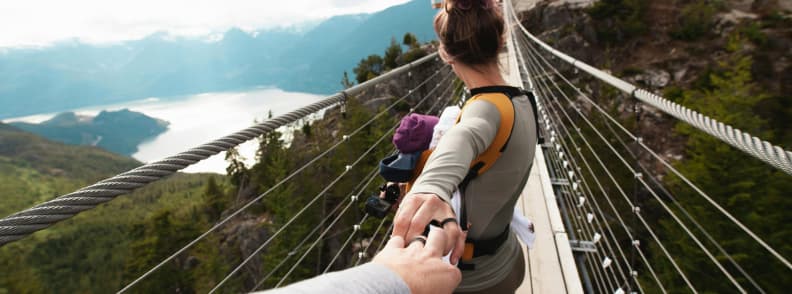
Final Thoughts on Traveling With a Baby
You don’t have to wait until they’re older. You don’t have to overpack or overspend. And you definitely don’t need to be perfect. Traveling with a baby is absolutely possible, whether you’re planning your first road trip baby loop, flying with a lap infant, or figuring out how to manage baby sleep while traveling across time zones.
With the right baby travel checklist, practical gear, a calm mindset, and honest expectations, you’ll be able to enjoy the trip and care for your baby at the same time. You now have answers for everything from TSA liquid rules for formula and medicine, to baby friendly hotels with cribs, to how to keep baby entertained on a long flight.
The hardest part is often leaving the house. Once you do, you’ll figure it out. I’ve cried in parking lots, rocked him through turbulence, and changed nappies everywhere, but I’ve also watched him fall asleep at the edge of a river, giggle while taking a bath in our camper’s sink, and dance on a quiet cobbled street.
This baby travel guide was built from all of that. Save it, share it, come back to it. Wherever you go next, you’ve got this.
Safe travels, from one parent to another.
About the Author

I’m Mirela Letailleur, a Romanian travel blogger living in the South of France, founder of The Travel Bunny. I’m also a mother, camper van road-tripper, slow-travel advocate, and expert in traveling with a baby across Europe on a budget.
I started flying with my baby at five months, took him on a road trip baby tour through France in a camper, and haven’t looked back since. I write honest, experience-based travel guides to help families plan smarter, stress less, and make room for naps, snacks, and real connection along the way.
You’ll find my advice grounded in practice, from baby travel checklist downloads to how we keep a baby sleep schedule while traveling without losing our rhythm (or our minds). If you’re planning a family trip and want real answers, you’re in the right place. Come along and I’ll help you go further with less stress, more clarity, and the confidence to take your baby anywhere.
After learning everything about traveling with a baby, check out these family travel guides
Lapland for Christmas: The Ultimate Guide to a Magical Escape
Family Holiday in Kenya: Plan the Perfect African Adventure
Tips for planning a trip to the mountains with your family

